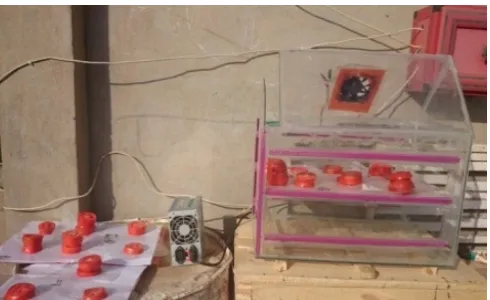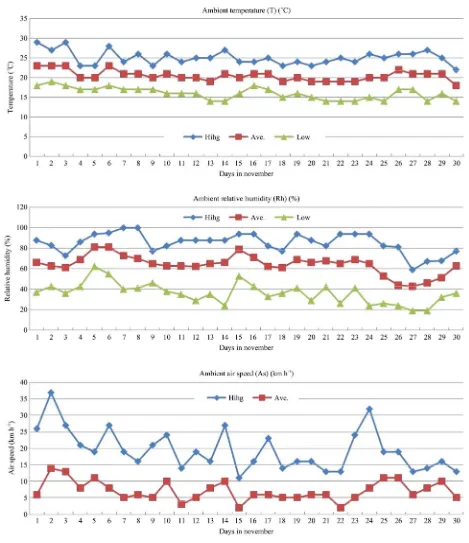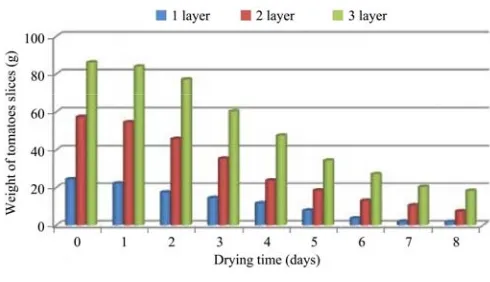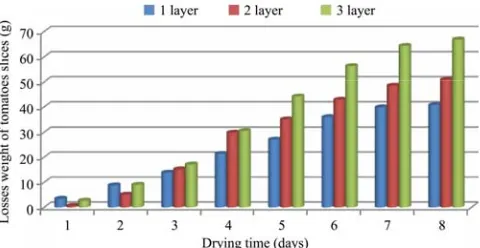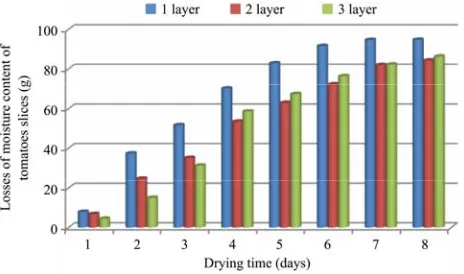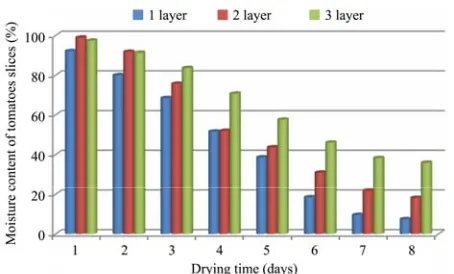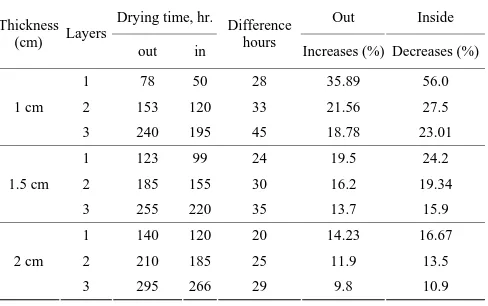Drying of tomato fruits using solar energy
Heba Abdel Mohsen
1, A. A. Abd El-Rahmam
2*, H. E. Hassan
3 (1. Researcher, Agric. Eng. Res. Institute, Agric. Res. Center, Egypt;2. Prof. of Agric. Eng. Res. Institute, Agric. Res. Center, Egypt;
3. Prof. of National Institute of Laser Enhanced Sciences (NILES), Cairo University, Egypt)
Abstract: The main aims of this work are fabricating simple solar dryer for tomatoes fruits drying, solar dryer and open solar drying were used to dry tomato slices, and study of drying time influences on moisture content losses and weigh of tomatoes slices. Also, to study various parameters such as relative humidity, temperature and velocity of air on tomatoes drying and compared to solar dryer and open solar dried during tomatoes fruits drying. Tomatoes are sliced to a thickness of about 1, 1.5 and 2.5 cm. The sliced tomatoes are arranged in single, two and three layers on surface of mats and left to dry naturally in the open solar and in solar dryer. Tomatoes dried at a time vary, based on the thickness layers of slices. Obtained results were: - The weight of all tomato slices was decreased by increasing drying time in opened solar drying and inside fabricated solar dryer. The weight of dried tomato slices was lower under the drying inside fabricated solar dryer than the drying in opened solar drying method.
- The losses of moisture content of all tomato slices were increased by increasing drying time in opened solar drying. But, the losses of moisture content of dried tomato slices were higher under the drying inside fabricated solar dryer than the drying in opened solar drying method. Because of the moisture content of all tomato slices was decreased by increasing drying time in opened solar drying. But, the moisture content of dried tomato slices was lower under the drying inside fabricated solar dryer than the drying in opened solar drying method.
- The solar dryer appears to be the effective and faster method of drying of tomatoes slices, because the drying time is very less compared with open solar drying. This is due to the solar drying effect inside the solar dryer where the temperature inside the dyer keeps on increasing with decrease in relative humidity inside the dryer.
Keywords: Tomato, moisture content, solar dryer, open solar drying, and drying time
Citation: Abdel Mohsen, H., A. A. Abd El-Rahmam, and H. E. Hassan. 2019. Drying of tomato fruits using solar energy. Agricultural Engineering International: CIGR Journal, 21(2): 204–215.
1 Introduction
In the present days, the demand for the tomatoes is
increasing steadily with an increase in population and its
likeliness towards tomato. The world average yield of
tomato is 23tonnes per hectare. At current time, spoilage
of fresh tomatoes is significant. Most of the natural food
drying methods can hardly provide products with desired
specifications because of adequate hygienic conditions.
Moreover, drying processes carried with conventional
fuel under a closed system have a high cost. Therefore,
Received date: 2018-09-24 Accepted date: 2018-11-01 * Corresponding author: A. A. Abd El-Rahman, Ph.D., Professor of Agricultural Engineering, Agricultural Engineering Institute, 256 Dokki, Egypt. Email: abdo_aaaa2000@yahoo.com.
systems using renewable energy sources like geothermal
and solar energy have become more widespread (Bansal,
1999).
Tiris et al. (1994) mentioned that there were two
methods to avoid spoilage and wastage of food stuffs
especially tomatoes. The first was the cold storage
method where the food stuffs will be stored in a highly
refrigerated room thereby enhancing the small-scale
farmers to meet the sudden and high demands in the
market without any significant wastage. This method is
an expensive one and small-scale farmers cannot afford it.
The second method is the product drying which is the
most appropriate solution for reducing spoilage, gaining
prolonged shelf-life and enhancing the market value of
the products, thereby allowing poor small-scale farmers
Vazquez et al. (1997) dried grapes using a
closed-loop drying mechanism heat pump at different air
speed rates and temperatures. Although grapes dried in
about 40 days under natural drying conditions, this time
reduced to 24 hours with the heat pump assisted system.
The authors reported that raisin characteristics like color
and quality did not alter with this drying system,
suggesting that such a drying system should be used in
industrial applications efficiently.
A greenhouse is essentially an enclosed structure
which traps the short wavelength solar radiation and
stores the long wavelength thermal radiation to create a
favorable micro-climate for higher productivity. A
greenhouse heating system is used to increase the thermal
energy storage inside the greenhouse during the day or to
transfer excess heat from inside the greenhouse to the
heat storage area. This heat is recovered at night to satisfy
the heating needs of the solar tunnel greenhouse dryer.
Thus, the temperature inside the dryer will be increasing
steadily, thereby ensure quicker drying of the products
than the open sun drying method. Various investigators
have studied the greenhouse for crop drying (Garg and
Kumar, 2000).
Drying process is the most significant form of food
preservation and also for its extended shelf-life. It is a
simultaneous heat and mass transfer process in which
moisture is removed from the food material by the hot air.
In this purpose, there have been many studies on the
drying behavior of vegetables and fruits such as sweet
pepper and garlic (Condori et al., 2001), tomato seed
(Sogi et al., 2003).
One of the major problems caused by these energy
sources is sustainability. Such a problem that may occur
before the drying process may cause foods to decay.
Therefore, in practice, systems working with fuel and
electricity were incorporated to these systems. Drying
systems are used not only for fruits and vegetables, but
also for products such as tobacco, tea leaf, hazelnut, corn
and in many areas such as textile, leather, rubber and
photograph industries. Products dried under natural
conditions may be exposed to dust, rain, harmful insects
and high temperatures (Madhlopa et al., 2002).
Olajide et al. (2003) estimated food loses due to
spoilage and mishandling in the lesser and
underdeveloped countries to fall between 25% and 40%.
It was noticed that increasing the temperature or velocity
of the drying air, the drying time decreased, while the
relative humidity decreased (Erenturk et al., 2005). On
the other hand, increasing the drying air temperature
decreased the equilibrium moisture content and the total
drying time (Simal et al., 2005). Chen et al. (2005) said
that it was difficult to control the quality specifications of
final products. Drying processes carried out in a closed
system, where drying parameters were better controlled
than natural drying; enable to obtain more hygienic and
acceptable products.
Fatouh et al. (2006) reported that product type,
loading quantity, drying air temperature and air speed had
an effect on drying rates. The authors noted that small
volume products had shorter drying time and less energy
consumption. Unit water quantity displaced, initial
product humidity rate, product geometry and diffusion
characteristics of product have an important role in drying
performance of a system, and drying cost is influenced by
the physical feature of a product, air flow and by-pass
evaporate rates 10.
Hawlader and Jahangeer (2006) indicated that there
was a high demand for inexpensive dried products with
high quality. In order to produce better and cheaper dried
products, energy must be used in a most productive way.
Using free energy sources like solar energy may reduce
the drying costs significantly. Kaya et al. (2007)
determined the effects of drying air temperature, air flow
rate and air relative humidity on the drying kinetics of
quince, apple and pumpkin using convective dryer.
Samaila et al. (2008) stated that harvested fruits were of
high moisture content which under tropical conditions of
high temperature and relative humidity were prone to
rapid post-harvest deterioration and losses of up to 30%-
69%. Therefore, during the vegetable peak period, there
were still a lot of vegetables available at low prices and
waste. The scarcity or non-availability of these crops in
their off seasons continued to be a common and ugly
experience of the poor farmers.
Therefore drying of tomatoes with a suitable
technology will enhance its shelf-life, prevent the wastage
of tomatoes. Open sun drying is a well-known food
method used to preserve agricultural product in the
tropical and subtropical countries. However, tomatoes
dried under natural conditions may be exposed to dust,
rain and high temperatures. In these conditions some
problems such as crack of the structure, bleaching,
hard texture, loss of flavor and nutritional properties,
low rehydration capacity, on-enzymatic browning which
makes tomatoes to worsen in its quality (Cernisev,
2010).
Rasim and Atalay (2012) showed that the tomatoes
were cut into either halves or quarters before drying.
Besides heat pump dehumidifier (HP) and solar-assisted
systems (SAS) at the drying air speed of 2 m.s-1 on
average, natural drying (ND) was also used for drying
experiments. Drying performance of HP was the best. In
general, SMER values of tomato quarters were higher
than those of tomato halves dried under same conditions.
Heat pump system presents great advantages for tomatoes
such as faster drying speed, less influence by
environmental factors (rain, dust, insects) and less
dependence on environmental conditions.
Arunet et al. (2014) mentioned that a natural
convection solar tunnel greenhouse dryer was designed
and developed for studying the drying characteristics of
tomatoes. Three experimental runs with 30 kg of
tomatoes were carried out in the dryer during the month
of June 2014. The performance of the dryer was studied
drying time and product quality in comparison with open
sun drying method. It was found that the solar tunnel
greenhouse dryer took only 29 hours for reducing the
moisture content of tomatoes from 90% (w.b.) to 9%
(w.b.) whereas the open sun drying took 74 hours for the
same. Also, the quality of dried tomatoes produced from
solar tunnel dryer is much superior compared to that of
open sun drying.
The main aims of this work are fabricating simple
solar dryer for tomatoes fruits drying, solar dryer and
open solar drying were used to dry tomato slices, and
study of drying time influences on moisture content
losses and weigh of tomatoes slices. Also, to studying
various parameters such as relative humidity, temperature
and velocity of air on tomatoes drying and compared to
solar dryer and open solar dried during tomatoes fruits
drying.
2 Materials and methods
Experiments were carried out under meteorological
conditions of Dakahliya Governorate. It located between
latitudes 30.5°, 31.5°, N, and longitudes 30°, 32° east
longitude. In Egypt during the November of 2015. On the
basis of measurement, at this location was used about
10 h per day. The experiments started at 10:00 a.m., and
measurements were done every two hours.
2.1 Sample preparation
Tomatoes (Lycopersiconesculentum) harvested with
90% to 94% moisture content wet basis, would
deteriorate after 3 to 5 days. Therefore, they were dried
until their moisture contents were reduced to about10%.
Tomatoes (25 kg for each experiment) were cut into
different thickness of about 1.0, 1.5 and 2.0 cm. The
sliced tomatoes were used in one, two and three layers on
surface of shelves and left to dry naturally in the open
solar and in solar dryer. Tomatoes dried at a time vary,
based on the thickness of slice and layers of slices.
2.2 Solar dryer
The solar dryer sampled from local materials were
fabricated and tested at Agricultural Engineering
Research Institute, Agricultural Research Institute; Egypt
is shown in Figure 1. Tomatoes on glasses shelves were
weighed at different time intervals to measure moisture
and weight loss.
The solar radiation is transmitted into the solar dryer
by the glass film. This glass film allows all the outside
solar radiations to pass into the solar dryer and prevents
the re-radiation from the solar dryer to the outside and
there by helps accumulating the heat the atmosphere
inside the solar dryer. Therefore, the temperature inside
the solar dryer was more than the ambient temperature.
This will help to remove the moisture content of the
tomatoes slices placed inside the solar dryer and therefore
they get dried.
2.3 Instrumentation
2.3.1 Ambient air and solar dryer air outlet temperature
Ambient air and solar dryer air outlet temperature
were measured with a digital type - T- thermocouple of a
24- channel outlet, omega digital thermometer and
mercury–in–glass thermometer.
2.3.2 Wind speed
measured using wind vane anemometer.
2.3.3 Air flow rate
Air flow rate was produced by a fan speed. Solar
energy system was installed with 45º fixed angle to
collect more solar radiation with heat air drying in
Dakahlia Governorate where the experiments were
carried out.
2.3.4 Determination of Moisture Content
The drying sliced tomatoes in the solar dryer and
open solar were sampled out periodically and the
moisture content in wet basis was measured by oven
drying method. Measurements were done at two hours
intervals in the day time for each batch drying.
Samples were cut and kept in electrical oven,
maintained at 105±1°C for 5 h. Initial (mi) and final mass
(mf) at time t. Samples were recorded using electronic
balance and repeated every 1 h interval till end of drying.
Moisture content on wet basis (Mwb) is defined as
Mwb=(mi–mf)/mi
where, mi and mf are initial and final weight of samples
respectively.
Figure 1 Solar dryer and solar open drying of tomatoes slice
3 Results and discussion
In the present study, the effect of drying method,
drying time, weight of tomatoes, thickness of slice and
tomato slice layers in the drying system on drying time
were studied.
The results indicated in solar dryer, the percentage of
drying time was about 56%, 27.5% and 23.1% faster than
solar opened drying which was about 35.9%, 21.6% and
18.7% for 1, 2 and 3 layers slices of tomatoes,
respectively at drying tomato slices with 1 cm thickness.
It was found that lighter tomatoes one layer and dried
faster than two and three layers of tomatoes slices.
Percentage of drying time of tomato slices with
1.5 cm thickness in solar dryer were about 24.2, 19.4 and
15.9% faster than solar opened drying which were about
19.5%, 16.2% and 13.7% for 1, 2 and 3 layers slices of
tomatoes, respectively.
At drying tomato slices with 2 cm thickness, drying
time of tomato slices in solar dryer was about 16.6%,
13.5% and 10.9% faster than solar opened drying which
was about 14.3, 11.9 and 9.8% for 1, 2 and 3 layers slices
of tomatoes, respectively.
Figure 2 shows values of weather factors during
drying of tomatoes including ambient temperature, air
speed and relative humidity through days in November in
Mansora region at Dakhlya Governorate.
The values of weather factors during drying of
tomatoes including ambient temperature, air speed and
relative humidity through days of number month. It
noticed that the values ( Maximum, average and
minimum) of high, average and low ambient temperature
were (29oC, 25oC and 22oC), (23oC, 20.5oC and 18oC)
and (19oC, 16oC and 14oC) respectively, the values
( Maximum, average and minimum) of high, average and
low ambient relative humidity were (100%, 85.23% and
59%), (81%, 64.1% and 43%) and (62%, 36.27% and
19%), respectively, and the values ( Maximum, average
and minimum) of high, and average ambient air speed
were (37, 19.5 and 11 km h-1) and (14, 7.13 and 2 km h-1),
respectively.
During the period of drying, the relative humidity of
the dryer varied between 41% and 77% whereas the
ambient relative humidity varies between 59% and 85%.
Because of the decreased relative humidity inside the
dryer (due to the solar dryer effect), the temperature
inside the dryer was high , varied between 22oC and 25oC
which is sufficient enough to dry the tomatoes. Whereas,
the ambient temperature was varied between 29oC and
36oC%.
During the period of drying, the ambient air velocity
varied between 19 and 39 m s-1 whereas the dryer air
velocity varied between 11 and 13 m s-1. It was evident
that the dryer air velocity is lesser than the ambient air
velocity due to there is no natural convection. This is the
reason for the lower air velocity and increased drying rate
Figure 2 Values of weather factors during drying of tomatoes (Temperature (T), air speed (As) and relative humidity (Rh)
Figures 3, 4 and 5 show that the relation between
weight of tomato slices and drying time with different
thickness of tomato slices (1, 1.5 and 2 cm) and different
layers of slices (1, 2 and 3 layers) during tomato drying
inside fabricated solar dryer. It was found that the tomato
slices have 3 layers was higher of the weight (60.06 g).
While, the tomato slices have 1 layer was lower of weight
(17.43 g). But, the weight of sample with two layers
slices was intermediate between samples with one and
three layers of slices (38.9 g).
Figure 4 Weight of different tomatoes slices during drying in solar drying inside solar dryer with thickness 1.5 cm
Figure 5 Weight of different tomatoes slices during drying in solar drying inside solar dryer with thickness 2 cm
Also, it was noticed that the weight of all tomato
slices was decreased by increasing drying time inside
fabricated solar dryer.
The weight of tomatoes slices with thickness 1 cm
was decreased (from 17.43 to 1.0 g), (from 38.9 to 1.97 g),
and (from 60.06 to 6.33 g) for layers one, two, and three
of tomatoes slices, respectively. Also, slices with
thickness 1.5 cm was decreased (from 27.23 to 1.7 g),
(from 68.36 to 8.50 g), and (from 109.46 to 19.66 g) for
layers one, two, and three of tomatoes slices, respectively.
As well as, slices with thickness 2 cm was decreased
(from 40.63 to 3.30 g), (from 61.57 to 11.33 g), and (from
101.70 to 37.53 g) for layers one, two, and three of
tomatoes slices, respectively.
Figures 6, 7 and 8 indicate that the relation between
weight of tomato slices and drying time with different
thickness of tomato slices (1, 1.5 and 2 cm) and different
layers of slices (1, 2 and 3 layers) during tomato drying in
opened solar drying. It was found that the tomato slices
have 3 layers was higher of the weight (70.83 g). While,
the tomato slices has 1 layer was lower of weight
(17.23 g). But, the weight of sample with two layers
slices was intermediate between samples with one and
three layers of slices (23.10 g).
Figure 6 Weight of different tomatoes slices during drying in opened solar drying with thickness 1 cm
Figure 7 Weight of different tomatoes slices during drying in opened solar drying with thickness 1.5 cm
Figure 8 Weight of different tomatoes slices during drying in opened solar drying with thickness 2 cm
The weight of tomatoes slices with thickness 1 cm
was decreased (from 17.23 to 1.0 g), (from 32.1 to 1.6 g),
and (from 70.83 to 8.73 g) for layers one, two, and three
of tomatoes slices, respectively. Also, slices with
thickness 1.5 cm was decreased (from 22.23 to 1.7 g),
(from 45.35 to 7.43 g), and (from 84.06 to 18.33 g) for
layers one, two, and three of tomatoes slices, respectively.
As well as, slices with thickness 2 cm was decreased
(from 33.07 to 1.90 g), (from 61.40 to 10.37 g), and (from
84.47 to 12.17 g) for layers one, two, and three of
tomatoes slices, respectively.
Also, it was noticed that the weight of all tomato
solar drying. But, the weight of dried tomato slices was
lower under the drying inside fabricated solar dryer than
the drying in opened solar drying method.
Figures 9, 10 and 11 illustrate that the relation
between losses weight of tomato slices and drying time
with different thickness of tomato slices (1, 1.5 and 2 cm)
and different layers of slices (1, 2 and 3 layers) during
tomato drying inside fabricated solar dryer. It was found
that the tomato slices have 1 layer were lower of the
losses weight (0.73 g). While, the tomato slices have 3
layers were higher of losses weight (1.87 g). But, the
weight of sample with two layers slices was intermediate
between samples with one and three layers of slices
(0.90 g).
Figure 9 Losses weight of different tomatoes slices during drying in solar drying inside solar dryer with thickness 1 cm
Figure 10 Losses weight of different tomatoes slices during drying in solar drying inside solar dryer with thickness 1.5 cm
Figure 11 Losses weight of different tomatoes slices during drying in solar drying inside solar dryer with thickness 2 cm
The losses weight of tomatoes slices with thickness
1 cm was increased (from 0.73 to 18.3 g), (from 0.90 to
37.83 g), and (from 1.87 to 45.47 g) for layers one, two,
and three of tomatoes slices, respectively. Also, slices
with thickness 1.5 cm was increased (from 1.16 to
26.70 g), (from 2.7 to 64.30 g), and (from 4.43 to
92.53 g) for layers one, two, and three of tomatoes slices,
respectively. As well as, slices with thickness 2 cm was
increased (from 0.63 to 40.80 g), (from 2.70 to 50.87 g),
and (from 3.47 to 66.87 g) for layers one, two, and three
of tomatoes slices, respectively.
Also, it was noticed that the losses weight of all
tomato slices was increased by increasing drying time
inside fabricated solar dryer.
Figures 12, 13 and 14 show that the relation between
losses weight of tomato slices and drying time with
different thickness of tomato slices (1, 1.5 and 2 cm) and
different layers of slices (1, 2 and 3 layers) during tomato
drying in opened solar drying. It was found that the
tomato slices have one layer were lower of the losses
weight (0.57 g). While, the tomato slices have three
layers were higher of losses weight (4.57 g). But, the
weight of sample with two layers slices was intermediate
between samples with one and three layers of slices
(2.70 g).
Figure 12 Losses weight of different tomatoes slices during drying in opened solar drying with thickness 1 cm
Figure 14 Losses weight of different tomatoes slices during drying in solar drying inside solar dryer with thickness 2 cm
The losses weight of tomatoes slices with thickness
1 cm was increased (from 0.57 to 16.80 g), (from 2.70 to
33.20 g), and (from 4.57 to 66.67g) for layers one, two,
and three of tomatoes slices, respectively. Also, slices
with thickness 1.5 cm was increased (from 2.13 to
22.70 g), (from 2.16 to 49.97 g), and (from 2.86 to
67.87 g) for layers one, two, and three of tomatoes slices,
respectively. As well as, slices with thickness 2 cm was
increased (from 2.83 to 34.00 g), (from 3.93 to 55.53 g),
and (from 4.50 to 76.23 g) for layers one, two, and three
of tomatoes slices, respectively.
Also, it was noticed that the losses weight of all
tomato slices was increased by increasing drying time in
opened solar drying. But, the losses weight of dried
tomato slices was higher under the drying inside
fabricated solar dryer than the drying in opened solar
drying method.
Figures 15, 16 and 17 show that the relation between
losses of moisture content of tomato slices and drying
time with different thickness of tomato slices (1, 1.5 and
2 cm) and different layers of slices (1, 2 and 3 layers)
during tomato drying inside fabricated solar dryer. It was
found that the tomato slices have one layer were higher of
the losses of moisture content (9.67%). While, the
tomato slices have three layers were lower of losses
moisture content (1.20%). But, the weight of sample with
two layers slices was intermediate between samples with
one and three layers of slices (2.26%).
The Losses of moisture content of tomatoes slices
with thickness 1 cm was increased (from 9.67 to 94.81%),
(from 2.26 to 95.05%) and (from 1.20 to 89.58%) for
layers one, two, and three of tomatoes slices, respectively.
Also, slices with thickness 1.5 cm was increased (from
4.10 to 94.01%), (from 6.09 to 88.32%) and (from 2.43 to
82.47%) for layers one, two, and three of tomatoes slices,
respectively. As well as, slices with thickness 2 cm was
increased (from 7.86 to 92.51%), (from 1.01 to 81.77%),
and (from 2.58 to 64.04%) for layers one, two, and three
of tomatoes slices, respectively.
Figure 15 Losses of moisture content of different tomatoes slices during drying in solar drying inside solar dryer with thickness 1 cm
Figure 16 Losses of moisture content of different tomatoes slices during drying in solar drying inside solar dryer with
thickness 1.5cm
Figure 17 Losses of moisture content of different tomatoes slices during period of solar drying inside solar dryer with thickness 2 cm
Also, it was noticed that the losses of moisture
content of all tomato slices were increased by increasing
drying time inside fabricated solar dryer.
Figures 18, 19 and 20 show that the relation between
losses of moisture content of tomato slices and drying
time with different thickness of tomato slices (1, 1.5 and
during tomato drying in opened solar drying. It was found
that the tomato slices have one layer were lower losses of
moisture content (3.18%). While, the tomato slices have
three layers were higher losses of moisture content
(7.75%). But, the weight of sample with two layers slices
was intermediate between samples with one and three
layers of slices (6.05%).
Figure 18 Losses of moisture content of different tomatoes slices during period of opened solar drying with thickness 1 cm
Figure 19 Losses of moisture content of different tomatoes slices during drying by opened solar drying with thickness 1.5 cm
Figure 20 Losses of moisture content of different tomatoes slices during drying by opened solar drying with thickness 2 cm
The Moisture content losses of tomatoes slices with
thickness 1 cm was increased (from 3.18 to 94.83%),
(from 6.02 to 94.38%) and (from 7.75 to 88.41%) for
layers one, two, and three of tomatoes slices, respectively.
Also, slices with thickness 1.5 cm was increased (from
8.88 to 93.03%), (from 4.99 to 87.05%) and (from 2.47 to
78.73%) for layers one, two, and three of tomatoes slices,
respectively. As well as, slices with thickness 2 cm was
increased (from 7.89 to 94.70%), (from 6.82 to 48.26%),
and (from 4.44 to 86.23%) for layers one, two, and three
of tomatoes slices, respectively.
Also, it was noticed that the losses of moisture
content of all tomato slices were increased by increasing
drying time in opened solar drying. But, the losses of
moisture content of dried tomato slices were higher under
the drying inside fabricated solar dryer than the drying in
opened solar drying method.
Figures 21, 22 and 23 show that the relation between
moisture content of tomato slices and drying time with
different thickness of tomato slices (1, 1.5 and 2 cm) and
different layers of slices (1, 2 and 3 layers) during tomato
drying inside fabricated solar dryer. It was found that the
tomato slices have three layers were higher of the
moisture content (90.32%). While, the tomato slices have
one layer were lower of moisture content (98.74%). But,
the weight of sample with two layers slices was
intermediate between samples with one and three layers
of slices (97.73%).
Figure 21 Moisture content of different tomatoes slices during period of solar drying inside solar dryer with thickness 1 cm
Figure 23 Moisture content of different tomatoes slices during period of solar drying inside solar dryer with thickness 2 cm
The moisture content of tomatoes slices with
thickness 1 cm was decreased (from 90.32 to 4.94%),
(from 97.73 to 5.18%) and (from 98.74 to 10.41%) for
layers one, two, and three of tomatoes slices, respectively.
Also, slices with thickness 1.5 cm was decreased (from
93.91 to 5.98%), (from 95.89 to 11.67%) and (from 97.56
to 17.52%) for layers one, two, and three of tomatoes
slices, respectively. As well as, slices with thickness 2 cm
was decreased (from 92.13 to7. 84%), (from 97.41 to
18.22%), and (from 98.98 to 35.95%) for layers one, two,
and three of tomatoes slices, respectively.
Also, it was noticed that the moisture content of all
tomato slices was decreased by increasing drying time
inside fabricated solar dryer.
Figures 24, 25 and 26 show that the relation between
moisture content of tomato slices and drying time with
different thickness of tomato slices (1, 1.5 and 2 cm) and
different layers of slices (1, 2 and 3 layers) during tomato
drying in opened solar drying. It was found that the
tomato slices have three layers were higher of the
moisture content (90.32%). While, the tomato slices
have one layer were lower of moisture content (98.74%).
But, the weight of sample with two layers slices was
intermediate between samples with one and three layers
of slices (97.73%).
The moisture content of tomatoes slices with
thickness 1 cm was decreased (from 2.24 to 4.59%),
(from 93.94 to 5.61%) and (from 96.81 to 11.58%) for
layers one, two, and three of tomatoes slices, respectively.
Also, slices with thickness 1.5 cm was decreased (from
91.12 to 6.96%), (from 95.00 to 12.95%) and (from 97.52
to 21.26%) for layers one, two, and three of tomatoes
slices, respectively. As well as, slices with thickness 2 cm
was decreased (from 92.10 to 5.29 %), (from 93.17 to
13.67%), and (from 95.55 to 15.73%) for layers one, two,
and three of tomatoes slices, respectively.
Figure 24 Moisture content of different tomatoes slices during period of opened solar drying with thickness 1 cm
Figure. 25 Moisture content of different tomatoes slices during period of opened solar drying with thickness 1.5 cm
Figure 26 Moisture content of different tomatoes slices during period of opened solar drying with thickness 2 cm
Also, it was noticed that the moisture content of all
tomato slices was decreased by increasing drying time in
opened solar drying. But, the moisture content of dried
tomato slices was lower under the drying inside
fabricated solar dryer than the drying in opened solar
drying method.
3.1 Variation of drying time in the open solar and
inside the solar dryer
Variation of drying time during drying of tomatoes
slices in the open solar and inside the solar dryer (Table
1). It was noticed that the differences time were 28, 33,
45 hours lead to increase in drying time percentage
35.89%, 21.56%, 18.78% at drying in the open solar
while lead to decrease in drying time percentage 56.0% ,
27.5%, and 23.1% at drying inside the dryer for drying
tomatoes slices 1 , 2 , and 3 layers, respectively.
Table 1 Variation of drying time during drying of tomatoes slices in the open solar and inside the solar dryer
Drying time, hr. Out Inside Thickness
(cm) Layers
out in Difference
hours
Increases (%) Decreases (%) 1 78 50 28 35.89 56.0 2 153 120 33 21.56 27.5 1 cm
3 240 195 45 18.78 23.01 1 123 99 24 19.5 24.2 2 185 155 30 16.2 19.34 1.5 cm
3 255 220 35 13.7 15.9 1 140 120 20 14.23 16.67 2 210 185 25 11.9 13.5 2 cm
3 295 266 29 9.8 10.9
3.1.2 For drying of tomatoes slice with 1.5 cm thickness
Variation of drying time during drying of tomatoes
slices in the open solar and inside the solar dryer (Table
1). It was noticed that the differences time were 24, 30,
35 hours lead to increase in drying time percentage 19.5%,
16.2%, 13.7% at drying in the open solar while lead to
decrease in drying time percentage 24.2% , 19.54%, and
15.9% at drying inside the dryer for drying tomatoes
slices 1, 2 , and 3 layers, respectively.
3.1.3 For drying of tomatoes slice with 2 cm thickness
Variation of drying time during drying of tomatoes
slices in the open solar and inside the solar dryer (Table
1). It was noticed that the differences time were 20, 25,
29 hours lead to increase in drying time percentage
14.23%, 11.9%, 9.8% at drying in the open solar while
lead to decrease in drying time percentage 16.67%,
13.5%, and 10.9% at drying inside the dryer for drying
tomatoes slices 1 , 2 , and 3 layers, respectively.
The sliced samples of tomato dried with solar dryer
and the open solar drying methods. To analyze the
system drying efficiencies and this revealed that tomatoes
slice. This showed that drying of tomatoes slices can
best be achieved by solar dryer than open solar drying.
The solar dryer appears to be the effective and faster
method of drying of tomatoes slices, because the drying
time is very less compared with open solar drying. This is
due to the solar drying effect inside the solar dryer where
the temperature inside the dyer keeps on increasing with
decrease in relative humidity inside the dryer.
4 Conclusion
The main aims of this work are fabricating simple
solar dryer for tomatoes fruits drying, and then the solar
dryer and open solar drying methods were used to dry
tomato slices, the concluded results were as following:
- The overall average solar dryer temperature was
higher than solar open drying.
- The results indicated that drying performance is
influenced by the product shape (1, 2 and 3 layers of
tomatoes slices) in solar dryer and the open solar drying
systems.
- The weight of all tomato slices was decreased by
increasing drying time in opened solar drying and inside
fabricated solar dryer. The weight of dried tomato slices
was lower under the drying inside fabricated solar dryer
than the drying in opened solar drying method.
- The losses of moisture content of all tomato slices
were increased by increasing drying time in opened solar
drying. But, the losses of moisture content of dried
tomato slices were higher under the drying inside
fabricated solar dryer than the drying in opened solar
drying method. Because of the moisture content of all
tomato slices was decreased by increasing drying time in
opened solar drying. But, the moisture content of dried
tomato slices was lower under the drying inside
fabricated solar dryer than the drying in opened solar
drying method.
- The solar dryer appears to be the effective and faster
method of drying of tomatoes slices, because the drying
time is very less compared with open solar drying. This is
due to the solar drying effect inside the solar dryer where
the temperature inside the dyer keeps on increasing with
decrease in relative humidity inside the dryer.
- The solar dryer appears to be the effective and faster
method of drying of tomatoes slices, because the drying
time is very less compared with open solar drying. This is
due to the solar drying effect inside the solar dryer where
the temperature inside the dyer keeps on increasing with
References
Arunet, S., S. Ayyappan, and V. V. Sreenarayanan, 2014. Experimental Studies on Drying Characteristics of Tomato in a Solar Tunnel Greenhouse Dryer. International Journal of Recent Technology and Engineering (IJRTE). ISSN: 2277-3878, 3(4): 32–37.
Bansal, N. K. 1999. Solar air heater applications in India.
Renewable Energy, 16(1-4): 618–623.
Cernisev, S. 2010. Effects of conventional and multistage drying processing on non-enzymatic browning in tomato. Journal of Food Engineering, 96(1): 114–18.
Chen, H., C. E. Hernandez and T. Huang, 2005. A study of the drying effect on lemon slices using a closed-type solar dryer.
Solar Energy, 78(1): 97–103.
Condori M., R. Echazu and L. Saravia, 2001. Solar drying of sweet pepper and garlic using the tunnel greenhouse drier.
Renewable Energy, 22(4): 447–460.
Erenturk S., M. S. Gulaboglu and S. Gultekin, 2005. The effect of cutting and drying medium on vitamin C content of rosehip during drying. Journal of Food Engineering, 68(4): 513–518. Fatouh, M., M. N. Metwally, A. B. Helali and M. H. Shedid, 2006.
Herbs drying using a heat pump dryer. Energy Conversion and Management, 47(15-16): 2629–2643.
Garg, H. P. and R. Kumar 2000. Studies on semi-cylindrical solar tunnel dryers: Thermal performance of collector. Applied Thermal Engineering, 20(2): 115 – 131.
Hawlader, M. N. A. and Jahangeer, K. A. 2006. Solar heat pump drying and water heating in the tropics. Solar Energy, 80(5): 492–499.
Kaya, A., O. Aydin and C. Demirtas. 2007. Concentration
boundary conditions in the theoretical analysis of convective drying process. Journal of Food Process Engineering, 30(5): 564–577.
Madhlopa, A., S. A. Jones and J. D. K. Saka, 2002. A solar air heater with composite-absorber systems for food dehydration.
Renewable Energy, 27(1): 27–37.
Olajide, J. O., O. J. Oyelade and A. T. Y. Tundeand, 2003. Design of a cabinet tray dryer for small and medium scale food processors. In Nigerian drying symposium series 1., University of Port – Harcourt, Nigeria.
Rasim K. and Ö. Atalay 2012. Comparison of drying characteristics of tomatoes with heat pump dehumidifier system, solar-assisted system and natural drying. Journal of Food, Agriculture and Environment, 8(2): 190–194.
Samaila, R. S., F. B, Olotu and S. I. Obiakor, 2008. Development of a manually operated fruit juiceextraction. Journal of Agricultural Engineering and Technology (JAET) 16(2): 22–28. Simal S., A. Femenia, J. A. Carcel and C. Rossell, 2005.
Mathematical modeling of the drying curves of kiwifruits: influence of the ripening stage. Journal of the Science of Food and Agriculture, 85(3): 425–432.
Sogi, D. S., U. S. Shivhare, S. K. Garg and A. S. Bawa, 2003. Water sorption isotherm and drying characteristic of tomato seeds. Bio systems Engineering, 84(3): 297–301.
Tiris C., N. Özbalta, M. Tiris and I. Dinçer, 1994. Experimental testing of a new solar dryer. International Journal of Energy Research, 18(4): 483–490.
